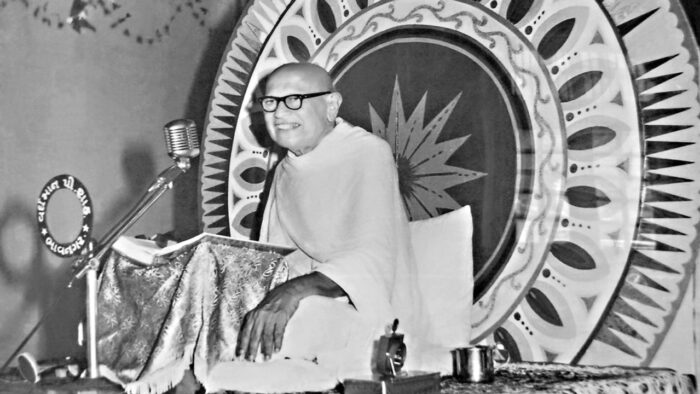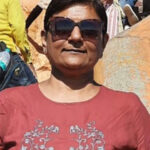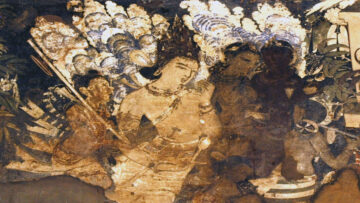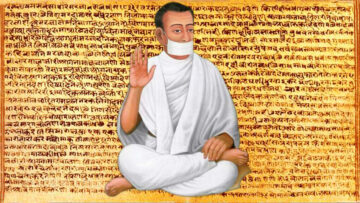Kanji Swami
Biographical Sketch
Kanji Swami was born in a Sthanakavasi family at Umrala, a small village in the Saurashtra region of Gujarat on Vaishakhsuda 2nd V.S. 1946 (A.D. 1889). His mother Ujamba and father Motichand were dasasrimali banias. Kanji, being bright and intelligent, was initiated into learning Jainism right from childhood and harbored yearnings of vairagya, seeking freedom from worldly things.
At the age of 11, Kanji experienced profound awakening while observing a ‘muni’ exuding supreme confidence in his freedom from worldly life. In that moment, he sensed that the muni possessed a wonderful state of mind, filled with unusual consciousness.. At such a tender age, his mind was attracted to a state, absolutely far from worldly attachments. Experiencing deepest recesses of mind, he was not satisfied with knowledge of words. His search was different. He was missing ‘Sat’- truth.
He was orphaned at a tender age and joined his father’s shop thereafter. He was simple, fearless and honest with frank expressions. Religious matters, especially Vairagya or freedom from worldly things,always deeply touched him.
Always engaged in reading religious books, he found out means to be free. He wanted to take Diksha, in spite of his brother and relative’s efforts to find him a life partner.
After an extensive search for a Guru, he ultimately renounced the world and embraced the life of a Jain saint under the guidance of Sri Hiracandaji Maharaja in A.D. 1913, within the Sthanakavasi sect. He studied Swetambara agamas with criticisms. He practiced an absolute code of conduct for munis.
He was a great believer in purusharthas (personal effort) for achieving salvation. Nothing else could help, he believed and this was his mission. He never believed that salvation would be achieved only when Kevali would have seen it in his infinite knowledge of the ultimate. He firmly believed and asserted that for those who are engaged in personal effort to source salvation, there are not many lives to live. The kevali in his supreme knowledge has never seen many lives, for such persons who are simply engrossed in personal endeavors. So for such persons, gain in terms of good life is not an incentive for liberation. They continuously strive for salvation. Their efforts remain supreme.
Once in his quest for truth, Kanji came across the Samayasara V.S. 1978 (in A.D. 1921), a great book of Kundakundacarya. Its wisdom brought him great joy, filling his heart with immense pleasure after he read the entire book. It marked a significant turning point in his life. Thus, Samayasara became his guiding book through which he expounded spirituality and philosophy throughout his life.
His inner self told him that the true path is the Digambara. In A.D. 1925, he read the book Moksa Marga Prakasaka which greatly influenced him, leading him to leave the Sthanakavasi sect, in A.D. 1934, even while being aware of difficulties that lay ahead. He became a Digambara Sravaka.
He said at that time that Jainism does not belong to any sect. It is a religion of the soul. When one realizes the magnanimity of the self and one’s interest in non-self objects vanishes, one fixes the attention on the pure nature of the self and thereby attains samyag darsana. His life was solely devoted to his own soul. His daily routine basically revolved around his own studies, his own knowledge, meditation and deep introspection of scriptures. Kanji Swami has given discourses on the following books: Satkhandagama part 1, Samayasara, Pravacanasara Pancastikaya, Astapahudas, Parmatmaprakasa, Niyamsara, Purusathasiddhiupaya, Moksa Marga Prakasaka and others.
Influcenced by him, many got initiatiated into the Jain monk order. Many people assumed Digambara faith. Songadha (Saurashtra) served as his primary location where these activities were conducted.
He died in V.S. 2037 (A.D. 1980)
As a Critique of Present Conditions
Kanji swami’s philosophy could be considered mainly as a revolt against the ritualistic aspect prevalent in the Jaina religion in his times. In and around him, he observed that the gurus were mainly emphasizing only the ritualistic aspect devoid of right faith, right knowledge and right conduct. He also found that Jaina teachers of his times gave sole importance to the material karmas and considered that the soul is mere puppet in the hands of those karmas. Hence the vision of the individual was shifted from the modifications of the perfect consciousness to the modifications of the karmic matter. He therefore raised his voice against this and by theorizing the philosophy of Kundakunda he propounded the revolutionary view of Krama Baddha Paryaya (sequence bound modifications). He therefore argues that the material karmas cannot modify the changes in the soul i.e. in consciousness. Further arguing he says that no substance can in any way bring about the changes in another substance. Soul is neither puppet nor the master of the karmas. No two substances affect each other; neither pudgala, especially neither karma pudgala, nor souls affect each other. No real bondage, no real salvation, i.e. no efforts for salvation takes place. The effect takes place solely due to the upadanakarana or the material cause; the nimitta or the instrumental has nothing to do with the bringing about the effect.
He even said ‘getting attached to Tirthankara nama karma needs to be left out. There is no misery to the soul at all even when the body suffers intensely in its various parts’. The path of salvation is not achieved by merely keeping balance of mind with an understanding that one should not mourn unhappiness since this will bring new karmas. Even the five vratas or penances bring punya but not salvation.
He used to live a highly saintly life of Sthanakavasi sadhus with perfect celibacy. Despite achieving ‘Graivaak’, the soul has come back to this world so what remains to be done now? Such was the subject of his deep meditation and study and he felt that the true path was something different. Formal ceremonies are not the path of salvation. The real path lies in self-experience of the soul.
Vyavahara and Niscaya Naya
The exponent of ‘standpoint’ was the great Jaina reformer Kundakundacarya .He belonged to the Digambara tradition of Jainism. Kundakunda’s spirituality is reflected in his famous work Samayasara. This work expounds the nature and working of consciousness and the non-conscious matter and the co-relation between them the Niscaya-Vyavahara are the two spiritual perspectives of understanding the self (samaya) in its pure nature and in its bound nature respectively. From the Niscaya perspective the soul is pure and at no point it is in bondage.
“The defining characteristic of the jiva is that it knows-that is its essence. Jiva and jnana, self or knower and knowledge are not different, they are identical; the knower is essentially one with knowledge.”[1]“It is the self, which can know anything because it is only the self, which has knowledge as its swabhava. Moreover, because of this it does not do anything in order to know- it has no need to act in order to obtain knowledge, knowledge is its condition”.[2]
And what it knows is precisely itself. Thus knowledge is not a matter of knowing something beyond or external to the self but of realizing or knowing one’s own true nature.
This was a total revolution by Kundakunda. He completely internalized the spirit of true religion; that is one has to know one is free and not bound. He completely broke the karta bhava.
“Pratikramana (repentance for past misconduct), pursuit of the good, rejecting the evil, concentration, abstinence from attachment to external objects, self-censure, confessing before the master and purification by expiation, these are eight kinds constitute the pot of poison”. [3]
“Non-repentance for past misconduct, non-pursuit of the good, non-rejection of evil, non-concentration, non-abstinence from attachments to external objects, non-self-censure, non-confessing before the masters and non-purification by expiation, these eight kinds constitute the pot of nectar”.[4]
In case of an empirical self, the uncontrolled rush of emotions must be kept under restraint. For achieving this purpose, the eight kinds of disciplines, Pratikramana etc. become necessary and desirable. Since they promote the achievement of the good, they must be said to constitute the pot of nectar. Whereas the lack of eight-fold discipline must constitute the opposite, that is, the pot of poison since there is a free vent to evil. The ordinary description is reversed in the last two verses by the author. He is talking of the transcendental self, which is quite beyond the region of good and evil. Hence, the question of discipline and non-discipline is meaningless. And hence in the case of the supremely pure state of the self, to talk of Pratikramana, etc., is to drag it down to the empirical level and to postulate the possibility of occurrence of impure emotions, which ought to be disciplined and controlled. Kundakunda considers the various kinds of moral discipline to be avoided and calls them pot of poison. When the self is absorbed in its own pure nature by attaining the yogic Samadhi, there is a full stop to the series of impure psychic states which are characteristics of the empirical self. Hence, there is no necessity to practice the various kinds of disciplines. The very absence of those disciplinary practices produces spiritual peace that passes understanding. It is that stage that there is the pot of nectar. Such a spiritual peace necessarily implies spiritual bliss, which is the characteristic of the supreme self.
Exposition of Kanji Swami’s Views
Krama Baddha Paryaya
Kanji Swami gave a doctrinal form to the spiritual path propounded by Kundakunda. He called the path Krama Baddha Paryaya (Sequence bound Modification).The principle of sequence bound modification means that the behavior pattern of the ever changing universe is bound by some order; whatever modifications in the substances are visible in this world, are happening in a definite orderly manner as if planned. The scheme of modifications, the substance is not only well planned, but it is completely independent also, that is, it does not depend on any other substance. No interference from other substance scheme sequence bound modification. In its own time, every change occurs and as such the modifications of every substance are sequence bound. These happen in their own time and according to the real self-force of the substances. Sequence means the planned exposition of the modifications and orderly means that the time of every modification is fixed according to the real intrinsic force of the substance.
He believed that substance (dravya) and modification (paryaya) both would take its own course. There is no interference from each one on the other.
Karta Bhava
The theory of Krama Baddha Paryaya destroys the pride of person that he himself is a doer. It introduces the individual as only the seer. The scheme of the nature of things assures you that you should remain carefree about the universe. Inaction does not mean that there is no agent or doer of this world but also that any one substance does not and cannot produce or destroy the modifications or bring about any changes whatsoever in other substances.
The commentaries of verses from 308 to 311 of sarvavisudha chapter that refer to sequence bound modifications have ultimately proved the concept of non-doing as is clear from the following exposition:
In this manner, an animate being is born of his own modification, and thus, the cause-effect relationship with inanimate objects does not stand proven. Because there is no creation-creator relationship between substances, when the cause–and-effect relationship is not established, the activity of a living entity in inanimate objects remain unproven. Similarly, the activity of animate objects remain unproven and the activity of animate objects in inanimate ones, lacking inherent proof, leaves the process of animating the inanimate by animate beings unverified. Thus animate being is not the doer of any deed.
“Each modification of consciousness is independent of non-self. It is complete in itself; it is completely capable of doing its own work, perfectly expert in doing it. In its capability the objects of consciousness are also definite. Whatever the capability of consciousness to know whatever objects, the modifications will make that substance alone the objects of consciousness. No other interference works.”[5]
Consciousness does not follow the objects but objects are known according to consciousness. This means whatever capability in incomplete consciousness is there to know particular objects, those objects alone become subjects of consciousness and not others.
Capability has been defined as the ability whose nature is the Ksayopasama of obstruction of the related karmas. That is to say whatever objects are to be known with that capability the related Ksayopasama of the obstruction of the related karmas is present.
The theory of Krama Baddha Paryaya comes very close to the theory of determinism. Determinism means everything in the world is determined. But the difference lies in the fact that Krama Baddha Paryaya also believes in Purushartha. Purushartha means to realize this very method of sequence bound modification and the principle of inaction. Purushartha or effort, according to Kanji Swami, is in acceptance of the principle of sequence bound modification wherein the false pride of doing vanishes and real effort of sentience rises.
The obvious question that arises is whether this would be equivalent to the denial of the doctrine of Samvayas, which is propounded in the Jaina scriptures? If Krama Baddha Paryaya were accepted there would be no place for Purushartha or human effort. Krama Baddha can be interpreted as a form of absolute determinism. Such a doctrine in which free will and human effort are denied would undermine the very foundation of morality and even spirituality. But Kanji Swami refutes this position and says that the non-acceptance of Krama Baddha is denial of true morality and spirituality and not the other way round. A denial of Krama Baddha Paryaya is the denial of the fundamental concept of omniscience (kevala jnana) according to Kanji swami. By accepting Krama Baddha Paryaya, one becomes free from anxiety and attains equipoise. The desire to make alterations in the natural course of events is the root cause of anxiety and other complicatedness. Belief in Krama Baddha Paryaya frees one of all these because the very foundation of kartabuddhi is ruined by Krama Baddha Paryaya.
“Whatever action or modification with whatever instrumental cause in a substance is to happen in whatsoever space or time that action takes place with that instrumental cause in that very substance, space and time and with the same process. Such a fixed scheme of events that rise in substance, place, time and modifications is called the principle of destiny from the point of view of fixed rise of karma. The same is termed as destiny from the point of view of fixed time it is called eventuality (kalalabdhi) .From the point of view of fixed modification that are to appear it is called future inevitability.”[6]
Monkhood –Not a Necessary Condition
Kanji Swami’s main emphasis was on one’s own understanding and knowledge. He says one who does not know who has no Jnana becomes the doer of good and evil things and even good and evil feelings and hence good and bad karmas. Whereas one who knows and understands that he should not have papa and punya if he wants salvation and therefore does not become a doer in such cases. Every soul has to be absolutely active in doing away such a sense of doing. This cannot happen without true knowledge. Hence follow the pursuit of knowledge and thereby achieve samyag darsana proper understanding.
He lays utmost emphasis on the niscayanaya and considers only the niscayamoksamarga as true dharma. He mentions explicitly that the Vyavahara point of view and its subject matter are not absolutely false. They do exist. But he emphasizes that the Vyavahara is useful only in order to know and understand the transitory and impure aspects of the self. But the reliance on these aspects is bound to lead to raga; hence Vyavahara is not to be followed. Only the niscaya is to be followed. Because niscaya refers to the permanent and pure aspect of the self, and reliance on it leads to vitaraga. On the basis of such an understanding Kanji Swami denounced monkhood. It goes to prove the real is the inner and any sort of external act only brings you down to the lower self.
His transformation from the Sthanakavasi to a Digambara sravaka was a great reform. And secondly he accepted the spiritual path of the Digambaras in the true sense and not on the basis of extreme conduct of nudity and aparigraha. He therefore challenged the extreme ritualistic path of the Swetambaras and the extreme external conduct of the Digambaras. He rejected all external ways of asceticism as a pre-condition for realizing the true nature of the self. He therefore remained a Sravaka throughout his life, preaching that self is merely a knower, and that all should embody JnayakaSwabhava.
Samyaktva
He emphasized on samyagdasa, a state of mind, which is the initial state for nirvana that is, when the soul gets completely detached from the worldly traits. One who has fully mastered all the sentiments and emotions prevailing in the entire universe attains Samyag darsana.
Formal ceremonies are not the path of salvation. Real path lies in self-experience of the soul after securing the soul itself and samyag darsana. Real sravakas path is complete absorption in experiencing and enjoying realization of the soul.
External penances and the various forms are merely manifestations of its incompleteness, its immaturity, without experiencing and realization of the soul. Samyag darsana is not something that is achieved by some external effort, it arises from within. Any attempt to produce samyag darsana is bound to fail. Effort to produce it is in fact a barrier for its occurrence, for all efforts are asahaja while the state of samyag darsana is sahaja/spontaneous, effortless.
Samyag darsana is first hand direct experience of the inner reality, which can be compared to the mystic experience as described by the mystics around the world. According to Kanji Swami, when the modification identifies itself with the eternal aspect of the self, it becomes pure even as the eternal aspect is pure. This is called anubhava. As long as the person identifies himself with the transitory modifications of the self and the non-self, he remains ignorant. But when he abandons the identification and recognizes the eternal nature of the self which transcends all distinction of qualities like darsana etc., he attains anubhava or samyag darsana.
The ajnani jivas take pleasure in knowing the special traits; the warned beings understand only the correct common traits. This is in essence the significance of the path of bondage the path of salvation.
Kanji Swami emphasizes that Jnana and Vairagya go together. That is to say when one realizes that a real knower is one who leads a spiritual life. For such a jnayaka swabhava one need not give up day-to-day activities. The condition is to keep in forefront self pure consciousness. This state becomes profound and gradually the state of the person will change. His conduct will turn into character and lead a vigilant life. Kanji Swami himself led a life of strict discipline and expected his followers to be firm in morality. In fact he compared morality to clothes emphasizing that morality is the preliminary requisite for one to become a truly religious man.
On Daya and Dana
In Jaina religion daya and dana are regarded as very important religious activities. In chapter five, acarya Bhiksu’s views on daya and dana, are discussed. Kanji Swami suggests a similar view point. He also asserts that these activities are subha kriya and are therefore heya (worth discarding); because this is not the true religion. The true religion is as expressed in the theory of Krama Baddhaparyaya.
But Kanji swami goes to the extent of building temples, publishing books etc. This he remarks; that these have come up on their own and that there is no any karta. The temples etc. are the modifications of that Pudgalaparyaya, therefore no karta or no data to build them.
The soul is distinct from the body and the true nature of the soul is pure knowledge. The activities of the body are beyond the authority of the self. The self is only the author of its own pure and impure states. The activities of the body are not the result of the self’s action. It is true that there appears a correlation between the activities of the body and human volition. But this is merely due to Nimitta Naimittik sambhandha a subtle co-relation, which is not causal in nature but may appear to be so to the superficial investigator. This relation is not causal because, the self is conscious by nature and the body is devoid of consciousness. As such, one cannot be the upadanakarana for the other and vice versa and only the upadanakarana is considered the true cause according to niscaya point of view. So nimitta-naimittikasambandha is non-causal relation. Actually Kanji Swami uses this doctrine, as a support to the spiritual discipline of ruminating on Akarta Bhava wherein a spiritual aspirant considers himself as a non-doer (Akarta). This convention of being Akarta assists him to retire from all forms of desires (auspicious or inauspicious) and get engrossed in the pure nature of the self.
[1] A. Chakarvarti’s commentary on Samayasara of Kundakunda, pp.232-233
[2] W. J. Johnson, Harmless Souls, p. 276.
[3] A. Chakravarti, Op.Cit. 9. 306.
[4] Ibid. , 9.307.
[5] HukumchandBharill, KramaBaddhaParyaya, p. 51.
[6] Ibid. , p. 56.
Feature Image Credit: vitragvani.com
Disclaimer: The opinions expressed in this article belong to the author. Indic Today is neither responsible nor liable for the accuracy, completeness, suitability, or validity of any information in the article.










